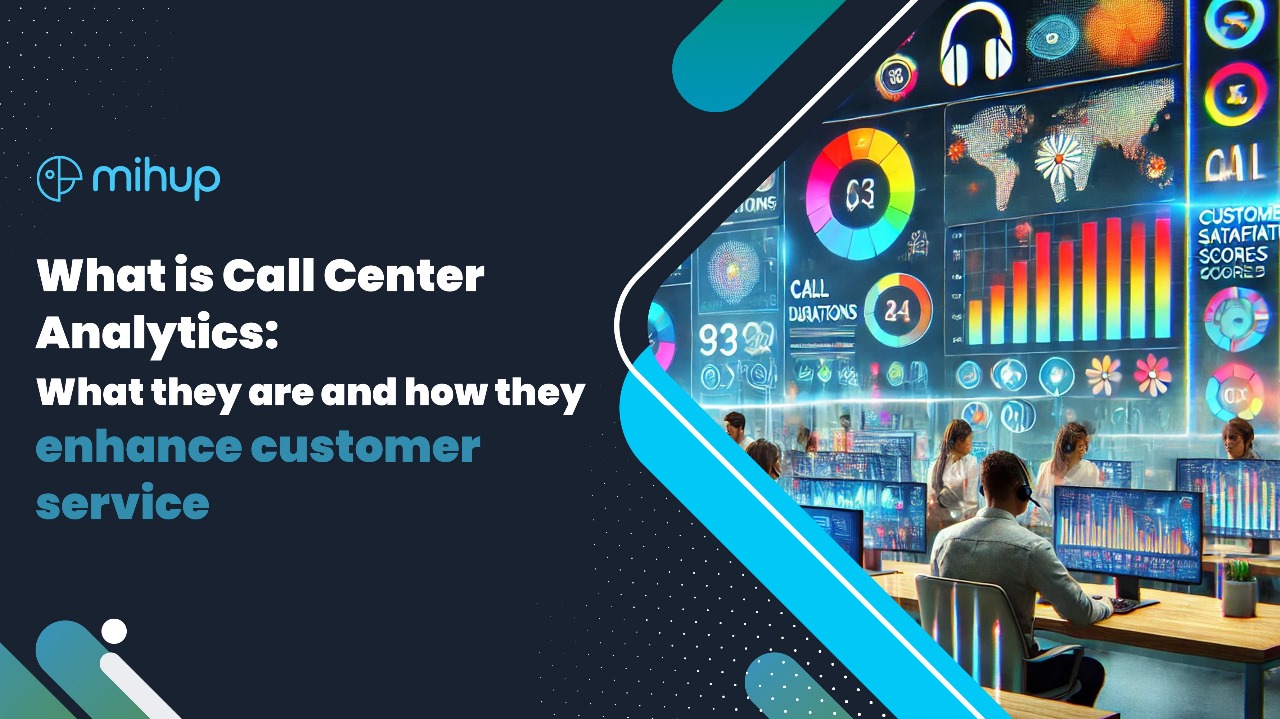A call center does not only refer to answering all customer inquiries these days. Modern call centers serve as strategic nodes for insights related to customer satisfaction, operational efficiency, and business growth. The goldmine from every customer contact, be it a call, chat, or email, presents a treasure trove of data on their needs, pain points, and preferences.
This wealth of information requires more than just listening; it demands the power of call center analytics. Advanced analytics tools can decode patterns, anticipate customer behavior, and proactively improve offerings. This transformation doesn’t just enhance service quality, it fuels smarter decision-making and builds stronger, long-term customer relationships.
We will delve into call center analytics in this blog: what it means, the various types, its importance in today’s competitive landscape, and best practices for maximizing its potential.
What is Call Center Analytics?
Call center analytics is the systematic process of capturing, analyzing, and leveraging data from customer interactions, whether through calls, chats, emails, or other channels to extract actionable insights. It goes beyond measuring performance metrics; it helps businesses understand customer behavior, identify trends, optimize operations, and enhance overall service quality. Turning raw interaction data into meaningful insights empowers organizations to make informed decisions, improve customer satisfaction, and drive better business outcomes.
Five Key Types of Call Center Analytics
With a wealth of data available, focusing on the most impactful analytics is critical for guiding operations and enhancing the customer experience. Here are five essential categories:
1. Business Intelligence
Business intelligence captures customer relationship data such as revenue, churn risk, and past touchpoints. This data helps agents:
- Prioritize high-value customers
- Offer personalized promotions
- Identify customers at risk of churning
- A comprehensive understanding of the customer journey enables agents to tailor interactions and focus on strengthening valuable relationships.
2. Interaction Analytics
Interaction analytics tracks performance indicators like response times, abandonment rates, resolution times, and call transfers. These analytics provide:
- Historical data
- Insights into trends and agent performance
- Use Case: Set performance goals, identify process bottlenecks, and monitor improvements over time.
3. Speech Analytics
Speech analytics uses AI and machine learning to analyze call recordings, identifying positive and negative keywords, sentiments, and topics. Key components include:
- Sentiment Analysis: Detects emotional states to identify dissatisfaction or urgency.
- Speech-to-Text Conversion: Transcribes audio for deeper analysis.
- Keyword Detection: Spots specific phrases indicating needs or compliance issues.
- Topic Classification: Organizes conversations by common issues or questions.
- Applications: Quality assurance, agent training, customer experience enhancement, and compliance monitoring.
4. Customer Surveys
Surveys are a direct channel for gathering feedback on experiences, satisfaction, and expectations. Common types include:
- Post-Call Surveys: Immediate feedback to measure CSAT and Net Promoter Scores (NPS).
- Email and SMS Surveys: Provide detailed feedback mechanisms.
- IVR Surveys: Automated, voice-driven surveys.
- Survey formats range from open-ended questions for detailed feedback to Likert scales measuring satisfaction intensity.
- Use Case: Recognize top-performing agents, guide coaching, and address common pain points.
5. Predictive Analytics
Predictive analytics uses machine learning to forecast future outcomes, such as call volumes and customer behavior. Core components include:
- Data Mining: Identifying patterns in large datasets.
- Statistical Analysis: Using regression models and probability to forecast trends.
- Machine Learning Algorithms: Predicting churn, inquiries, and optimal responses.
- Applications: Optimize staffing, enhance customer experience, and improve agent performance.
Types of Call Center Analytics
There are several types of analytics that businesses can use to make their call centers more efficient and effective:
1. Predictive Analytics
Predictive analytics uses past data to predict future outcomes.
For instance, it can predict busy call times or recurring customer issues. This helps businesses prepare in advance, ensuring they have enough agents or resources available during peak times.
Predictive analytics can also help in planning for product launches, promotions, or new campaigns, reducing the risk of service disruptions.
2. Interaction Analytics
Interaction analytics reviews customer conversations—whether they are calls, emails, or chats.
By analyzing these interactions, businesses can understand common customer concerns, track how agents handle calls, and identify areas where service can improve.
This type of analytics is also helpful when scaling services or launching new features, as it ensures customer feedback is considered.
3. Speech and Text Analytics
Speech and text analytics analyze the content and tone of customer interactions.
For instance, the analysis of call recordings or live chat transcripts can tell if the customer has positive or negative sentiments about the product and the service. Businesses can use the data to look for patterns that have frequent complaints or recurring customer inquiries.
It also reviews agents’ performance and ensures that agents respond based on the customer’s concern.
4. Customer Journey Analytics
Customer journey analytics maps how customers interact with a business across multiple channels: phone, email, chat, or social media.
By following the whole journey, businesses can identify problem areas, like where customers drop off or face difficulty. Fixing these issues results in smoother customer experiences and higher satisfaction.
5. Self-Service Analytics
Many customers try to solve issues themselves using resources like chatbots, FAQs, or help articles.
These interactions are analyzed by companies so that they would know where their customers have the most problems. For instance, one question asked to the chatbot again and again may indicate that the content of self-help may be lacking on a certain aspect.
These improvements reduce calls and save time and money, besides helping customers solve the issues more quickly.
Why Call Center Analytics is Important?
Call center analytics is like a guide to navigating customer interactions. It gives clear insights that help businesses make better decisions and deliver a higher level of service.
Analytics helps businesses understand what the customers need and expect, identifies common problems and fixes them fast, tracks agent performance for better training, improves efficiency by reducing call times and wait times, and creates strategies based on reliable data instead of guesswork.
For instance, according to a McKinsey report, firms employing analytics reduce costs, achieve higher self-service success rates, and shorten the call duration; therefore, there is an enhanced customer experience, as well as cost savings.
Best Practices for Call Center Analytics
1. Right Tools
- Invest in Scalable Tools: Opt for solutions that can handle high call volumes, diverse data formats, and rapid data processing. Cloud-based platforms with AI capabilities are often ideal, as they offer scalability and cost-efficiency.
- Leverage AI and Machine Learning (ML): Tools with AI/ML capabilities can detect patterns and trends, offering predictive insights about customer behavior. For example, they can forecast call spikes, enabling better resource allocation.
- Analytics: Dashboards enable supervisors to monitor calls as they happen, identifying issues like long hold times or customer dissatisfaction to take immediate corrective actions.
- Insight: Companies using advanced analytics tools can reduce average handling time (AHT) by up to 20% and improve first-call resolution (FCR) rates.
2. Integrate Speech and Text Analytics
- Unified Analytics Systems: By analyzing calls, emails, chats, and social media interactions together, businesses gain a holistic view of customer preferences and pain points.
- Cross-Channel Trends: Integration helps identify cross-channel patterns. For instance, recurring complaints on email may mirror issues highlighted in calls, indicating a systemic problem.
- Enhanced Sentiment Analysis: Combining speech and text analytics improves the accuracy of sentiment analysis, identifying frustrated or dissatisfied customers across all channels.
- Insight: Businesses using unified analytics report a 360-degree view of customer interactions, leading to a 25% improvement in customer satisfaction (CSAT) scores.
3. Ensure Data Accuracy and Integration
- Data Governance Frameworks: Implement governance protocols to ensure data accuracy, consistency, and integrity across all sources.
- Automated Data Cleaning: Use automation to remove duplicates, correct errors, and standardize formats across datasets.
- Integrated Platforms: Connect call center data with CRM, ERP, and customer feedback systems to ensure seamless data flow and a single source of truth.
- Insight: Accurate, integrated data reduces the risk of decision-making errors, which could otherwise cost businesses up to 10% of annual revenues.
4. Security and Compliance
- Data Encryption: Ensure all customer data, both at rest and in transit, is encrypted to prevent unauthorized access.
- Regular Audits: Conduct frequent audits to check for vulnerabilities and ensure compliance with laws such as GDPR, HIPAA, and CCPA.
- Access Control: Use role-based access controls (RBAC) to ensure that only authorized personnel can view or handle sensitive customer information.
- Insight: Trust in data security boosts customer loyalty, with 84% of customers more likely to stay loyal to businesses that prioritize their data protection.
5. Continuous Improvement
- Periodic Review of KPIs: Regularly evaluate key performance indicators (KPIs), such as Net Promoter Score (NPS), CSAT, AHT, and FCR, to adapt to evolving customer needs.
- Feedback Loops: Establish feedback loops with frontline agents to gain insights into recurring issues and areas for improvement.
- Adopt Agile Practices: Use agile methodologies to quickly implement changes based on analytics insights and customer feedback.
- Insight: Businesses that continuously refine their analytics processes achieve a 30-40% improvement in operational efficiency and customer retention over time.
By adopting these best practices, businesses can unlock the full potential of call center analytics. Not only does this lead to improved operational efficiency and cost savings, but it also strengthens customer relationships and positions businesses for long-term success.
How Mihup.ai May Assist
Mihup.ai’s advanced interaction analytics helps businesses unlock valuable insights from customer conversations across multiple channels. Here’s how it can transform your operations, explained in simple terms:
1. Analyze Customer Conversations
Mihup.ai uses speech and text analytics to understand what customers are saying and how they feel.
- What it does: It listens to phone calls, reads chats, and analyzes emails to identify common complaints, recurring issues, and customer emotions (like frustration or satisfaction).
- How it helps: You’ll know exactly what makes your customers happy or upset, so you can quickly fix problems and improve your services.
2. Improve Agent Performance
Mihup.ai tracks agent-customer interactions to identify areas where agents might need help.
- What it does: It spots patterns like agents giving incomplete answers, taking too long to respond, or struggling with complex queries.
- How it helps: Managers can use this data to create targeted training programs, helping agents perform better and resolve issues faster.
3. Optimize Self-Service Channels
By analyzing chatbot conversations and FAQ usage, Mihup.ai identifies the gaps in self-service options.
- What it does: It checks what customers are asking the chatbot and how often they can’t find the answers they need.
- How it helps: You can update FAQs or improve chatbot responses, making it easier for customers to solve problems without waiting for an agent.
4. Predict Trends with Predictive Analytics
Mihup.ai uses its data-crunching power to forecast future patterns.
- What it does: It analyzes past interactions to predict busy periods (like holidays or product launches) and common customer concerns.
- How it helps: Businesses can prepare in advance by scheduling more agents, creating FAQs for anticipated questions, or fine-tuning responses to common issues.
5. Ensure Data Security and Compliance
Mihup.ai prioritizes keeping customer data safe and compliant with privacy regulations like GDPR and CCPA.
- What it does: It encrypts sensitive data, limits access to authorized personnel, and complies with legal requirements.
- How it helps: This builds trust with customers and avoids costly legal issues.
Key Benefits of Mihup.ai’s Interaction Analytics
- Reduce Call Volumes: By improving self-service options, more customers can help themselves, lowering the need for live agent support.
- Improve Efficiency: Analytics-driven insights streamline operations, saving time and resources.
- Deliver a Seamless Customer Experience: Understanding and addressing customer needs leads to happier, more loyal customers.
In simple terms, Mihup.ai takes the guesswork out of customer service by turning raw conversations into actionable insights. It helps businesses anticipate customer needs, fix issues faster, and build a more efficient, customer-friendly call center.
Conclusion
Call center analytics is essential for improving customer service, reducing costs, and making informed decisions. By understanding customer behavior, businesses can address problems before they escalate, improve agent performance, and ensure a smooth customer journey.
With solutions such as Mihup.ai, companies can now move their analytics up a notch by unlocking invaluable insights and ensuring long-term success. It’s high time for companies to take a leap towards call center analytics, thus using it as a tool for growth and customer satisfaction.





